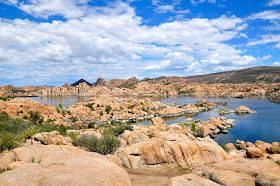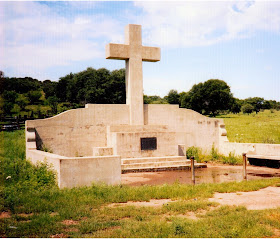Credit: Linda & Dr. Dick Buscher
1. Archeologists speculate that over 10,000 Native American ruin sites are scattered across the State of Arizona. Some like Montezuma Castle National Monument, shown above, are highly refurbished and advertised by the National Park Service which oversees their preservation and protection. Montezuma Castle National Monuments is located near an interstate highway in the Verde Valley of Arizona and receives over 400,000 visitors each year.
Credit: Linda & Dr. Dick Buscher
2. Others are spectacular ruins, like the Honanki Heritage Site but are protected only by the 1906 Antiquity Act, state ordinances and local tour guides and volunteers. Honanki Heritage Site is located in Loy Canyon near the tourist destination of Sedona, Arizona but has never received the influx of money needed to make it a designated national monument nor even a state park. It, like so many other archeological ruins, survives after 800 years of existence trusting that vandals won’t ignore the laws and destroy it.
Credit: Linda & Dr. Dick Buscher
3. Many of Arizona’s archeological ruins are located on one of the 20 Indian Reservation that are found within Arizona. Far too many continue to fall into desolation do to lack of resources as well as cultural considerations. All are protected by the Antiquity Act as well as the laws of the local tribes who work hard to protect their cultural history. Kinishba ruins, shown above, is located near historic Fort Apache in Whiteriver, Arizona on the White Mountain Apache Indian Reservation. It is a large and spectacular ancient pueblo that was built between 1250 - 1350 CE but is challenged each year with more and more deterioration.
Credit: Linda & Dr. Dick Buscher
4. Fortunately the federal government has designated 8 of the 20 national monuments found in Arizona to the preservation of ancient Native American sites. One of the most remote yet impressive of these national monument is Navajo National Monument. Located in the northwest section of the Navajo Nation in northern Arizona, Navajo National Monument protects and preserves three magnificent cliff dwellings built by the Ancestral Puebloan people during the 13th century. Each of the ancient pueblos are believed to have been constructed by a people named by the Navajo as the Anasazi. We have no idea what the Anasazi called their cliff dwelling but the modern Navajo people have named the ruins Betatakin, Keet Seel and Inscription House.
Credit: Linda & Dr. Dick Buscher
5. Navajo National Monument is relatively small in size - only some 360 acres (150 ha). It is located on the Colorado Plateau at the transition zone between the Great Basin and Upper Sonoran deserts. The climate tends to be hot and dry but at an elevation of 7,300 feet (2225 m), the winters can be very cold. The national monument is located on a large plateau between Black Mesa, 20 miles to the southeast and Navajo Mountain, 30 miles to the northwest.
Credit: Linda & Dr. Dick Buscher
6. Betatakin (Beh-TAH'-tah-kin), is the easiest of the three Navajo National Monument ruins to view and visit. The pueblo sits nestled in an alcove of Jurassic-age Navajo sandstone mesa atop an underlying layer of the Kayenta Formation. The top of the mesa rises some 7,200 feet (2,195 m) above sea level while the nearby canyon floor is at an elevation of 6,400 feet (1,951 m). Betatakin is a Navajo word that means “ledge house”. The cliff dwelling is located in Tsegi Canyon, one of a maze of canyons found across the Colorado Plateau and carved over the millennia by running streams.
Credit: NPS
7. The alcove in which Betatakin was built faces south to gather the warmth of the winter sun. It is 452 feet (138 m) high and 370 feet (113 m) deep. At the apex of its use, Betatakin was bustling pueblo of 135 rooms with a population of over 100 Anasazi. The people were farmers, cultivating the nearby canyon floor with fields of corn and squash. Today only 90 ancient rooms remain under the large rock ceiling. Slabs of rocks falling from the ceiling of the alcove remain even today, a problem and danger for those visiting the ancient pueblo. Only stabilization of walls has occurred at Betatakin with no reconstruction having taken place.
Credit: NPS
8. Keet Seel or Kiet Siel (Kįtsʼiil) is according to some archeologists the best preserved Anasazi ruin ever discovered. When first seen, many visitors comment that it looks as if the pueblo was only recently abandoned. Tree ring dating suggests that Keet Seel was built around 950 CE and abandoned around 1300 CE. But to see this magnificent cliff dwelling is a challenge involving a strenuous 17-mile round trip hike with a drop of 1,000 feet (305 m) into the main branch of Tsegi Canyon by way of steep switchbacks before miles of hiking on sandy slopes, and wading through local streams while avoiding patches of quicksand.
Credit: NPS
9. Kiet Siel is a Navajo word that translates to mean "broken pottery scattered around”. Some 150 rooms are found at the ruins all constructed from sandstone blocks plastered together with mud. Several kivas and pithouses are also found within the ruins. Archeologists believe that most of the rooms were used for food storage while a few served as living quarters. The estimated 150 people who once lived here grew a variety of food in their canyon floor fields that included beans, squash, corn and cotton. Domesticated turkeys were also a part of the people’s food supply. Skeletal remains of a macaw from southern Mexico was also found at Keet Seel. The southeast facing alcove in which the pueblo was built greets the warm morning sun while providing early afternoon shade during the hot summer months.
Credit: NPS
10. Inscription House is the third of the three magnificent cliff dwellings found in and protected at Navajo National Monument. Unlike Betatakin and Keet Seel, Inscription House is found under a large, high arching sandstone cliff on the north side of a branch of Nitsin Canyon. The ruins consists of only 74 rooms that include living quarters, granaries and one kiva. Tree-ring dating suggest that Inscription House was build around 1274 CE, about the same time as the other two larger pueblos of Navajo National Monument. The Inscription House name is somewhat unusual rising from an inscription left on one of the ruin’s plastered walls and first noted in 1909 by two explorers, Byron Cummings and John Wetherill. Later, Wetherill would recall that that inscription read “C H O S 1661 A d n”. Today, Inscription House is closed to visitors due to the many unstable walls and the desire of local canyon residence for privacy.
Credit: NPS
11. From the rim of Tsegi Canyon, visitors to Navajo National Monument can find the trails that lead to the ruins of both Betatakin and Keet Seel. The view above from the rim looks for miles over canyon after canyon of Navajo sandstone which is actually a 200-million year old solidified sand dune left by the ancient seas that once covered this part of the southwestern United States. Ancestors of the Hopi People lived in these canyons for thousands of years, long before the arrival of the Navajo. The Hopi name for Keet Seel is Kawestima, meaning “snowy place” and was home to the Hopi Fire, Burrowing Owl, Flute, Deer, Snake and Bighorn Sheep Clans. Betatakin is known as Talastime, meaning “place of the blue corn tassels”, and was home to the Deer, Fire, Flute and Water Clans. Inscription House is called Tsu’ovi, meaning “place of the rattlesnake, and is home to the Rattlesnake, Sand and Lizard clans. For the modern Hopi People, these ruins are spiritually active and a direct link to their ancestral past.
Credit: NPS
12. Because of its remote location, the spectacular cliff dwellings found at Navajo National Monument only receive around 105,000 visitors each year. But for those who choose to go “off the beaten path” and even enjoy a wilderness experience without large crowds, the solitude, serenity and cliff dwellings found at Navajo National Monument are still a natural and historic treasures awaiting to be discovered and both emotionally and intellectually experienced.
Credit: USGS
13. Navajo National Monument preserves and protects some of America’s best ancient cliff dwellings. The Navajo say they were built by the Anasazi people; the Hopi say they were built by the Hisatsinom people and modern archeologists refer to the builders as Ancestral Puebloans - three names for the same people. We have no idea what the people called themselves but what they did without steel nor a domesticated animals larger than a dog is impressive even by today’s standards. A 13th century drought probably drove the people from their alcove homes. Lloyd Masayumptewa, a Hopi and a monument archeologist sums up best the challenge of living in this high Colorado Plateau land - “Rock – water – people. The mandala is no different for us than it was for them. They tried to cope with a long drought in the 1200s, as we cope now. And they knew that everyone lives in this country only with the blessing of the land and sky.”





























































